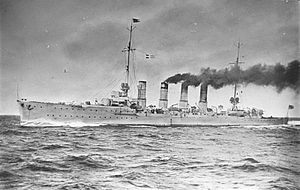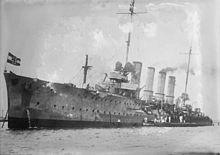Karlsruhe-class cruiser
 SMS Karlsruhe
| |
| Class overview | |
|---|---|
| Builders | Germaniawerft and Howaldtswerke |
| Operators | |
| Preceded by | Magdeburg class |
| Succeeded by | Graudenz class |
| Built | 1911–1914 |
| In service | 1914–1916 |
| Planned | 2 |
| Completed | 2 |
| Lost | 2 |
| General characteristics | |
| Type | Light cruiser |
| Displacement |
|
| Length | 142.20 m (466 ft 6 in) |
| Beam | 13.70 m (44 ft 11 in) |
| Draft | 5.38 m (17 ft 8 in) |
| Installed power |
|
| Propulsion |
|
| Speed | 29.3 kn (54.3 km/h; 33.7 mph) |
| Complement |
|
| Armament |
|
| Armor |
|
The Karlsruhe class of
Both of the ships had short service careers. Karlsruhe was assigned to overseas duty in the Caribbean, arriving on station in July 1914, days before the outbreak of World War I. Once the war began, she armed the passenger liner SS Kronprinz Wilhelm so it could raid British shipping. After a moderately successful commerce raiding career, during which Karlsruhe sank sixteen merchant ships and successfully evaded British cruisers, she sank after an accidental internal explosion on 4 November 1914. Most of her crew were killed in the sinking, but the survivors returned to Germany on one of Karlsruhe's attendant colliers by December.
Rostock served as a torpedo boat flotilla leader with the High Seas Fleet following her commissioning; her flotilla frequently screened for the battlecruisers in the I Scouting Group, including during the Battle of Dogger Bank in January 1915 and operations off the British coast in early 1916. She saw heavy action during the Battle of Jutland on 31 May – 1 June 1916 as part of the screen for the main battle fleet. In the ferocious night fighting that occurred as the German fleet punched through the British rear-guard, Rostock was torpedoed by a British destroyer, which immobilized the ship. She was taken under tow by several torpedo boats, but early on the morning of 1 June, the cruiser HMS Dublin located the cruiser. To prevent her capture by the British, the Germans scuttled the ship after taking off her crew.
Design
The design for the Karlsruhe class was prepared in 1910, and was an incremental improvement over the previous
Dimensions and machinery
The Karlsruhe class ships were 139 meters (456 ft)
Karlsruhe and Rostock were powered by two sets of Marine-type
Armament and armor
Karlsruhe and Rostock were armed identically to the previous Magdeburg-class cruisers. They carried a main battery of twelve 10.5 cm (4.1 in) SK L/45 guns in single pedestal mounts. Two were placed side by side forward on the forecastle, eight were located amidships, four on either side, and two were side by side aft. The guns had a maximum elevation of 30 degrees, which allowed them to engage targets out to 12,700 m (41,666 ft 8 in).[3] They were supplied with 1,800 rounds of ammunition, for 150 shells per gun. The ships were also equipped with a pair of 50 cm (19.7 in) torpedo tubes with five torpedoes submerged in the hull on the broadside. They could also carry 120 mines.[1]
The ships' armor was also identical to the preceding class. They were protected by a waterline
Service history

SMS Karlsruhe
After her commissioning, Karlsruhe was assigned to overseas duties in the Caribbean, where she was to relieve the cruiser Dresden.[4] She arrived in the area in July 1914, days before the outbreak of World War I.[5] Once the war began, she armed the passenger liner SS Kronprinz Wilhelm so it could operate as a commerce raider, but while the ships were transferring equipment, British cruisers located them and pursued Karlsruhe.[6] Her superior speed allowed her to escape, after which she operated off the northeastern coast of Brazil.[7]
Karlsruhe refueled at Puerto Rico, a possession of the then neutral United States before steaming to Brazil. Off the Brazilian coast, she captured or sank sixteen ships totaling 72,805 gross register tons (GRT) while eluding her pursuers. The ship's captain then decided to operate against the shipping lanes to Barbados.[7] While en route on 4 November 1914, a spontaneous internal explosion destroyed the ship and killed the majority of the crew, including her captain. The survivors used one of Karlruhe's colliers to return to Germany in December 1914.[8]
SMS Rostock

Rostock served with the High Seas Fleet as a leader of torpedo boat flotillas for the duration of her career.[2] She served with the screens for both Rear Admiral Franz von Hipper's battlecruisers of the I Scouting Group on operations against the British coast and the Battle of Dogger Bank. During the battle, British battlecruisers ambushed the German squadron and sank the armored cruiser Blücher. In April 1916, she again screened the battlecruisers during the bombardment of Yarmouth and Lowestoft, during which Rostock and five other cruisers briefly engaged the British Harwich Force.[9]
She was assigned to the screen for the battle fleet during the Battle of Jutland on 31 May – 1 June 1916. She saw major action at Jutland and frequently engaged British light forces, including assisting in the destruction of the destroyers HMS Nomad and Nestor.[10] Rostock's participation in the battle culminated in her torpedoing by destroyers shortly after midnight. She was taken under tow by German torpedo boats, but the following morning the cruiser HMS Dublin came upon the retreating ships. To prevent Rostock's capture, the Germans set scuttling charges aboard her and took off the crew before firing torpedoes into the disabled cruiser to ensure she sank.[11]
Notes
References
- ISBN 978-1-84415-300-8.
- Campbell, John (1998). Jutland: An Analysis of the Fighting. London: Conway Maritime Press. ISBN 978-1-55821-759-1.
- Campbell, N. J. M. & Sieche, Erwin (1986). "Germany". In Gardiner, Robert & Gray, Randal (eds.). Conway's All the World's Fighting Ships 1906–1921. London: Conway Maritime Press. pp. 134–189. ISBN 978-0-85177-245-5.
- ISBN 978-0-87021-790-6.
- Halpern, Paul G. (1995). A Naval History of World War I. Annapolis: Naval Institute Press. ISBN 978-1-55750-352-7.
- Tarrant, V. E. (1995). Jutland: The German Perspective. London: Cassell Military Paperbacks. ISBN 978-0-304-35848-9.
Further reading
- ISBN 978-1-68247-745-8.
- Koop, Gerhard & Schmolke, Klaus-Peter (2004). Kleine Kreuzer 1903–1918: Bremen bis Cöln-Klasse [Small Cruisers 1903–1918: The Bremen Through Cöln Classes] (in German). München: Bernard & Graefe Verlag. ISBN 3-7637-6252-3.
- Nottlemann, Dirk (2021). "The Development of the Small Cruiser in the Imperial German Navy (Part II)". In Jordan, John (ed.). Warship 2021. Oxford, UK: Osprey Publishing. pp. 44–60. ISBN 978-1-4728-4779-9.
